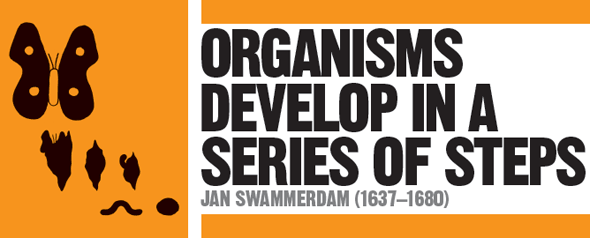
IN CONTEXT
Biology
c.320 BCE Aristotle declares that worms and insects arise by spontaneous generation.
1651 English physician William Harvey considers the insect larva a “crawling egg” and the pupa a “second egg” with little internal development.
1668 Italian Francesco Redi provides early evidence to refute spontaneous generation.
1859 Charles Darwin explains how each stage of an insect’s life is adapted to its activity and environment at that stage.
1913 Italian zoologist Antonio Berlese proposes that an insect larva hatches at a premature stage of embryo development.
1930s British entomologist Vincent Wigglesworth finds hormones control life cycles.
The metamorphosis of a butterfly from egg to caterpillar to chrysalis to adult is a familiar process to us today, but in the 17th century, reproduction was viewed very differently. Following the Greek philosopher Aristotle, most people believed that life – especially “lower” creatures such as insects – arose by spontaneous generation from non-living matter. The theory of “preformism” held that a “higher” organism took its fully mature form in its miniscule beginning, but that “lower” animals were too simple to have complex innards. In 1669, pioneering Dutch microscopist Jan Swammerdam disproved Aristotle by dissecting insects under the microscope, including butterflies, dragonflies, bees, wasps, and ants.
"In the anatomy of a louse, you will find miracles heaped on miracles and will see the wisdom of God clearly manifested in a minute point."
Jan Swammerdam
A new metamorphosis
The term “metamorphosis” had once meant the death of one individual followed by another’s appearance from its remains. Swammerdam showed that the stages in an insect’s life cycle – adult female, egg, larva and pupa (or nymph), adult – are different forms of the same creature. Each life stage has its own fully formed internal organs, as well as early versions of the organs for later stages. Seen in this new light, insects clearly warranted further scientific study. Swammerdam went on to pioneer the classification of insects based on their reproduction and development, before dying of malaria, aged 43.
See also: Robert Hooke • Antonie van Leeuwenhoek • John Ray • Carl Linnaeus • Louis Pasteur